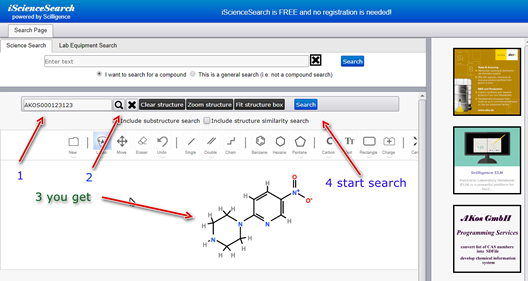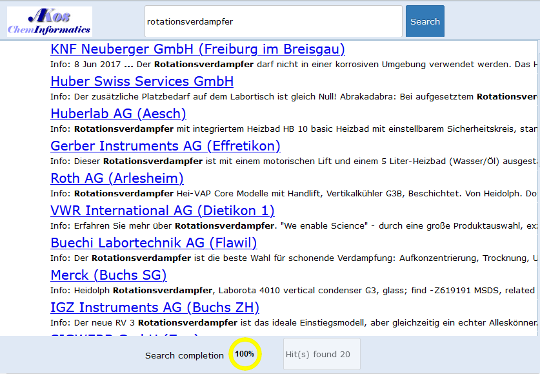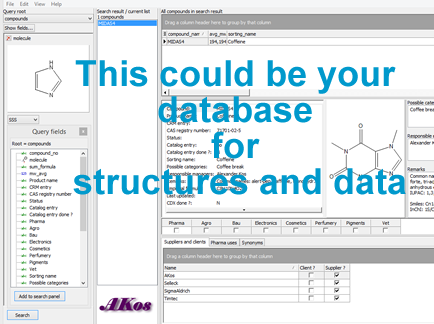|

- iScienceSearch is the Internet
search engine for chemist
- search by structure or identifier
(name, CAS Registry Number, AKos number, Smiles, etc.)
- search for suppliers - more
comprehensive than Google
- automatic search for multiple
synonyms .... more
|
AKos
ILMAC Search
System (https://akoscheminformatics.de/ilmac/)
is an example of an Internet search system for a special
interest area. We search over all exhibitors of the
2020/2021 ILMAC. This system searches over the internal
search system on the homepage of the exhibitors, and at the
same time makes a Google search limited to the web pages of
the exhibitors.
 Another
example of an Internet search system for a special interest
area is iScienceSearch (see left). In this case the interest
area is chemistry. Another
example of an Internet search system for a special interest
area is iScienceSearch (see left). In this case the interest
area is chemistry.
We can provide quickly search systems for other interes
areas.
The advantages are...more
|

AKos ChemInformatics and
Biochemfusion developed a inhouse chemical database
system based on RDKit and PostgreSQL. This is a
multiuser system ...more
|

Programming knowhow:
Oracle, SQL Server, ACCESS,.Net,
Webservices, Microsoft, Web
programming,Chemoinformatics, MDL, ChemAxon,
Scilligence, GGA, RDKit, KNIME...more
|
|

is
a
free Chemical information
System to load (Register) and search SDFiles
by structure on your own (Published)
website or computer...more
|
 |
|

The largest glass property database SciGlass
7.7 contains data for more than
- 360 thousand glass compositions
including more than
- 16 thousand halide and about
- 35 thousand chalcogenide glasses.
|
Wendy Warr published an interresting article on the
National Institutes of Health (NIH) Workshop on Reaction Informatics
Abstract
The virtual workshop took place on May 18-20, 2021. It was a follow-up
from the December
2020 NIH Workshop on Ultra Large Chemistry Databases.
A major theme emerging from the December 2020 workshop was the fact that
all the databases of a billion or more structures are virtual. For each
virtual molecule the question then arises of whether, or how, it can be
synthesized. The organizers therefore assembled speakers to give
presentations about how reaction-related data are represented, captured,
managed in databases, analyzed, used for drug design, applied in
robotics, and exchanged locally as well as globally. This report
summarizes talks from 27 practitioners in the reaction informatics
field. The aim is to represent as accurately as possible the information
that was delivered by the speakers; the report does not seek to be
evaluative. The themes, in the order used for this report, were reaction
representations, file formats, and standards; sources of reaction data;
AI and machine learning applications of reaction-related data in de novo
drug design, synthetic accessibility, synthesis planning, reaction
prediction etc.; and automation and progression toward autonomous
synthesis.
see:https://chemrxiv.org/engage/chemrxiv/article-details/611cf1a6ac8b499b36458d19
Warr W. National Institutes of Health (NIH) Workshop on Reaction
Informatics. ChemRxiv. Cambridge: Cambridge Open Engage; 2021; This content
is a preprint and has not been peer-reviewed.
|
private
do you play Sudoku? |
